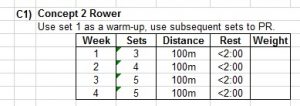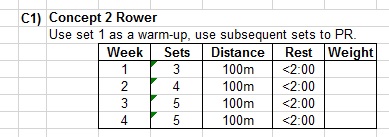The Concept 2 Rower is a staple in our programs. Though many of our remote programming clients, swimmers, and other athletes have a large base of aerobic conditioning from their sport-specific training, the rower provides a variety of benefits that these athletes not otherwise develop.
It is rare that we program 1,000m rows and even more rare that we program repeats at this length or anything longer. The 500m row done as a single, stand-alone workout cap, or for repeats is very common.
Using the rower helps athletes engage in and acclimate to an extended position that they may not otherwise be experiencing on a regular basis. Though it is true that many athletes participate in sports that rely on extension (football, swimming, weight lifting), the majority of the time these athletes are resting in a passive flexion, largely relying on the spine and non-muscular soft tissue structures for support.
To achieve this extension, the glutes must be largely responsible for the hips, as power is produced against the foot clasps and transferred through the upper extremities into the handle. This glute activation is critical for athletic development. When we reduce the distance, we maximize the amount of effort the glutes are eliciting, while simultaneously increasing exercise intensity (more total effort being generated while doing so with greater effort of the target muscles).
This is also why we program box jumps and deadlifts into such simple and short sets. This keeps the central nervous system fresher, downregulates oxidative fatigue, and ensures better movement with less compensation throughout the exercise.
To expand on the value of these shorter sets, consider the various times in which you, or fellow gym-goers have injured yourselves on either deadlifts or box jumps; if this has happened to you, chances are it was towards the end of a high rep set as fatigue was setting in. This is when the jumps get choppier (and louder) or the deadlifts begin to rely on more and more of a bounce to achieve the next rep. This chop or bounce is more likely associated with CNS fatigue than muscular fatigue itself.
You can avoid all of this with shorter, more focused sets.
This more precise and intentional strategy is just one more reason why we like this short rowing set so much; more time can be spent consciously thinking about the movement pattern, ingraining good technique significantly faster.
Good technique on the rower leads to enhanced function of the spine, improved coordination between the upper and lower body, faster times, and an overall safer, more productive training experience.
100m Rows with Limited Rest

Much like in the world of swimming, individuals conflate distance for success; just because you’ve done more doesn’t mean you’ve done better. The 100m Row done for repeats is a great place to, not only challenge your anaerobic capacity, but also engrain proper mechanics on the rower.
Broadly speaking, we’ll start our athletes on 3×5 sets of 100m rows, going up to somewhere around 5-10x by the end of a 4 week cycle. These usually start with somewhere around a 2:00 rest, but these tend to get shorter as time goes on.

